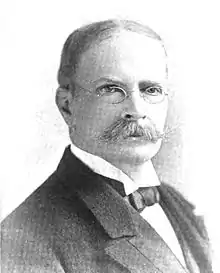James Lane Allen
James Lane Allen (December 21, 1849 – February 18, 1925) was an American novelist and short story writer whose work, including the novel A Kentucky Cardinal, often depicted the culture and dialects of his native Kentucky. His work is characteristic of the late 19th-century local color era, when writers sought to capture the vernacular in their fiction. Allen has been described as "Kentucky's first important novelist".

Early life and education
James Lane Allen was born near Lexington, Kentucky, to Richard and Helen Jane (Foster) Allen on December 21, 1849.[1] Allen, the youngest child in the family, had four sisters Lydia, May, Sally, and Annie, and two brothers, John and Henry.[1] Allen lived at the Scarlet Gate estate in Lexington in the late 1800s until age 22 years.[2]
In 1872 Allen graduated from the University of Kentucky, Lexington, taught at Fort Spring, Kentucky, at Richmond and at Lexington, Missouri, and from 1877 to 1879 at the academy of the University of Kentucky, where he was principal and taught modern languages. In 1880 he was professor of Latin and English at Bethany College (West Virginia); and then became head of a private school at Lexington, Kentucky.[3] Allen spent his youth in Lexington during the Antebellum era, the American Civil War, and the Reconstruction periods.[1] His childhood experience heavily influenced his writing. He described living at Scarlet Gate in the introduction to A Kentucky Cardinal.[2]
Career in New York
In 1893 Allen moved to New York City, where he lived until his death. He was a contributor to Harper's Magazine, The Atlantic Monthly, and other popular magazines of the time. His novels include The Choir Invisible, which was a very popular best seller in 1897.[4][5]
Death and legacy
Allen died "from insomnia" in 1925, [5] and is buried in Lexington Cemetery. At the northern edge of Gratz Park in Lexington is the "Fountain of Youth", built in memory of Allen using proceeds willed to the city by him.[6]
James Lane Allen School, an elementary school off Alexandria Drive in Lexington, Kentucky is named in his honor.
Bibliography
Works published by Allen include:
- Flute and Violin (1891) (compilation of previously published stories)
- The Blue-Grass Region of Kentucky (1892) (second compilation)
- John Gray (1893)
- A Kentucky Cardinal (1894)
- Aftermath (1895) (sequel to A Kentucky Cardinal)
- Summer in Arcady (1896)
- The Choir Invisible (1897)
- Two Gentlemen of Kentucky (1899)
- The Increasing Purpose (1900)
- The Reign of Law (1900)
- The Mettle of the Pasture (1903)
- The Bride of the Mistletoe (1909)
- The Doctor's Christmas Eve (1910)
- The Heroine in Bronze (1912)
- The Last Christmas Tree (1914)
- The Sword of Youth (1915)
- A Cathedral Singer (1916)
- The Kentucky Warbler (1918)
- The Emblems of Fidelity (1919)
- The Alabaster Box (1923)
- The Landmark (1925)
Notes
- Knight, Grant C. (December 2012). "James Lane Allen and the Genteel Tradition". uncpress.unc.edu. The University of North Carolina at Chapel. Retrieved 2020-06-09.
- "The Lexington School buys neighboring James Lane Allen estate". kentucky. Retrieved 2020-06-09.
-
 One or more of the preceding sentences incorporates text from a publication now in the public domain: Chisholm, Hugh, ed. (1911). "Allen, James Lane". Encyclopædia Britannica. 1 (11th ed.). Cambridge University Press. p. 691.
One or more of the preceding sentences incorporates text from a publication now in the public domain: Chisholm, Hugh, ed. (1911). "Allen, James Lane". Encyclopædia Britannica. 1 (11th ed.). Cambridge University Press. p. 691. - (6 October 1946). Fifty Years of Best Sellers, compiled in Popular Culture
- (19 February 1925). James Lane Allen, Author, Dies at 76: Creator of "The Choir Invisible" Collapses In Roosevelt Hospital From Chronic Insommnia, The New York Times
- Gratz Park Historic District, Lexington, Kentucky -- National Register of Historic Places Travel Itinerary at www.cr.nps.gov
Further reading
- Bennett, Enoch Arnold (1901). "Mr. James Lane Allen." In: Fame and Fiction. London: Grant Richards, pp. 171–180.
- Bottorff, William K. (1964). James Lane Allen. New York: Twayne Publishers.
- Klotter, James C. (1992). "Allen, James Lane". In John E. Kleber (ed.). The Kentucky Encyclopedia. Associate editors: Thomas D. Clark, Lowell H. Harrison, and James C. Klotter. Lexington, Kentucky: The University Press of Kentucky. ISBN 0-8131-1772-0. Retrieved November 30, 2011.
- Knight, Grant C. (1935). James Lane Allen and the Genteel Tradition. Chapel Hill: The University of North Carolina Press.
- Townsend, John Wilson (1928). James Lane Allen: A Personal Note. Louisville, Ky.: Courier-journal Job Printing Company.
External links
| Wikisource has original works written by or about: James Lane Allen |
| Wikimedia Commons has media related to James Lane Allen. |
- Works by James Lane Allen at Project Gutenberg
- Works by or about James Lane Allen at Internet Archive
- Works by James Lane Allen at LibriVox (public domain audiobooks)

- James Lane Allen, by George Brosi
- Works by James Lane Allen available online
- James Lane Allen at Find a Grave
- James Lane Allen: A Sketch of his Life and Work